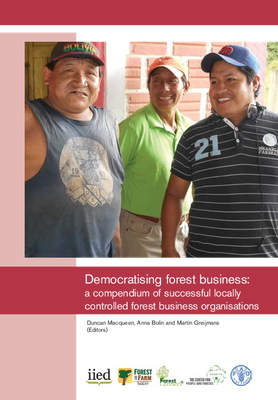Democratising forest business: a compendium of successful locally controlled forest business organisations

The main purpose of this book is to present 19 case studies from 14 developing countries that show how local people have been democratising forest business. By this is meant the process of asserting collective local control through ownership and management arrangements so that the integrated needs of families, communities and indigenous peoples remain central to the business operation.
Location: Africa: Burkina Faso, Ethiopia, The Gambia. Latin America and Caribbean: Bolivia, Brazil, Guatemala, Mexico. Asia: Cambodia, Indonesia, Laos, Nepal, Thailand, Philippines, Vietnam
Key points in document:
- This book reviews 19 “successful” forest businesses or enterprises found in 14 countries chosen by Forest and Farm Facility and Forest Connect alliance.
- Each case study is broken down into five categories: the enabling environment; the business model; the ownership structure; how challenges were overcome; and the critical success factors for the enterprise.
- The final section of the book uses the five categories above to synthesize the key lessons learned from the 19 case studies and what is required to develop a “successful” forest enterprise.
Information relevant to Learning Questions:
- Are enabling conditions in place to support a sustainable enterprise?
- Stakeholder alignment, diversification
- Market demand, profit potential, access to credit/capital
- Ownership, governance
- Government requirements, policies for enterprises, business alliances
- Financial management capacity, technical capacity
- Inputs, equipment, infrastructure
- Benefit sharing, targeted participants, combined strategic approaches, biodiversity linkage, policies for and enforcement of resource use, external disturbance
- Does the enterprise lead to benefits to stakeholders?
- Increased income for participants
- Non-cash benefits
- Do the benefits lead to positive changes in attitudes and behavior?
- Not addressed
- Does a change in stakeholders’ behaviors lead to a reduction to threats to biodiversity (or restoration)?
- Agriculture and aquaculture
- Biological resource use
- Human intrusions and disturbance
- Invasive and other problematic species and genes
- Climate change and severe weather
- Does a reduction in threats (or restoration) lead to conservation?
- Forest ecosystems
- Freshwater ecosystems
- Grassland ecosystems
- Species
Enterprise Types:
- Crops: coffee, cashews
- Sustainably-harvested timber products
- Non-timber forest products: baobab, shea, tamarind, xate, resin, frankincense
- Marine/freshwater ecotourism
- Terrestrial ecotourism
- Other natural products: beekeeping, charcoal briquette, paper, woven fabric
Document type
- Case-study

